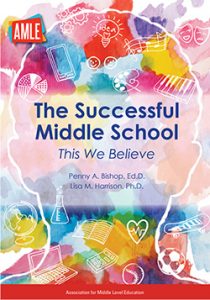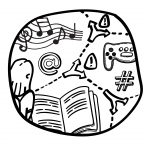The Successful Middle School Online Course Series
The Successful Middle School: This We Believe, AMLE’s landmark position paper now in its fifth edition, provides a foundational, research-supported overview of best practice in the middle grades. Successful middle schools exhibit 18 characteristics to support an education for young adolescents that is responsive, challenging, empowering, equitable, and engaging.
The Successful Middle School Course Series explores each of these essential attributes and characteristics in a self-paced, virtual format with exercises and reflections throughout to help learners understand how to realize and embed these principals in their daily practice. Complete these individually, or together as a team, based on your learning preference.
Upon finishing the series, complete the final post-assessment to claim a contact hours certificate documenting 4.0 hours of learning.
Module 1: The Middle Level Mindset
In this module, we’ll take a look at something we’re already intimately familiar with – the critical role that middle level educators play—not just in the lives of young adolescents—but in society. Then, we’ll also cover the history of middle level philosophy and the evolution of The Successful Middle School.
Module 2: The Essential Attributes and Characteristics of Successful Middle Schools
In this module, we’ll take a quick look at how the attributes and characteristics are related to each other in the middle school philosophy and how they support the development of young adolescents. We’ll then take a closer look at each of the attributes and characteristics before we dive deeper into each characteristic and the middle level mindset in the coming lessons!
Module 3: Educators Respect and Value Young Adolescents
In this short module, we’ll look at the student-teacher relationship and why it’s so important to build strong bonds, create trauma-free spaces, and work with family partners. We’ll also look at the necessity of responding to young adolescents’ complex identities and experiences with sensitivity and an advocacy mindset. Then we’ll finish with a look at how our respect for young adolescents requires us to hold ourselves to the highest standards in order to model positive relational, emotional, wellness, and learning behaviors.
Module 4: The school environment is welcoming, inclusive, and affirming for all.
In this module, we’re going to dig a little deeper into the school culture that we create together—we strive to create an environment that is welcoming, inclusive, and affirming for students, for each other, and for ourselves. This environment is based in a culture that sustains the dignity of all members within the school community. Then we’ll talk about how to deal with prejudice, both in ourselves and in our schools and, finally, we’ll talk about how to foster social inclusivity in our classrooms.
Module 5: Every student’s academic and personal development is guided by an adult advocate.
In this module, we’ll talk about why advocacy is critical to any successful middle school and learn what a good advocacy program looks like.
Module 6: School safety is addressed proactively, justly, and thoughtfully.
We all know how important school safety is; so, in this module we’ll cover the importance of safety policies and practices as well as the climate of safety in a school. We’ll also talk about how the visible aspects of safety contribute to a school’s climate and how to manage those aspects.
Module 7: Comprehensive counseling and support services meet the needs of young adolescents.
In this module, we’ll take a look at why counseling and support services are so critical for the success of young adolescents and middle school schools.
Module 8: The school engages families as valued partners.
In this module, we’ll cover one of your most critical partnerships as an educator—the family partnership. No two family partnerships look exactly the same but we’ll discuss a helpful framework of six types of partnerships that can help you assess and strategize for improving your collaborations with families. Lastly, we’ll look at how you engage families and some specific considerations for engagement.
Module 9: The school collaborates with community and business partners.
In this module, we’re going to take a look at why community and business partnerships are so good for everyone at the school. We’ll also cover the components of a successful partnership program.
Module 10: Educators are specifically prepared to teach young adolescents and possess a depth of understanding in the content areas they teach.
In this module, we’ll cover the very important professional preparation that middle level educators must receive to teach young adolescents and the qualities of a successful preparation.
Module 11: Curriculum is challenging, exploratory, integrative, and diverse.
In this module, we’ll look at the many competing demands on the curriculum and our role as educators in advocating for the needs of young adolescents. We’ll discuss not just this official curriculum and content but also the meta-curriculum, that curriculum which is communicated through unspoken behaviors, subtle language, structures, and systems, as well as the issues that occur and how they are dealt with. Most importantly, we’ll look at the qualities of a curriculum that meets the needs of young adolescents—one that is challenging, exploratory, integrative, and diverse.
Module 12: Health, wellness, and social-emotional competence are supported in curricula, school-wide programs, and related policies.
In this module, we’ll discuss the importance of helping students understand their own development and giving them the skills to maintain physical and social-emotional well-being, which they will need over their lifetime. Then we’ll cover the components of a coordinated health and wellness program and your role within that program.
Module 13: Instruction fosters learning that is active, purposeful, and democratic.
In this module, we’ll look closely at what it means for learning to be active, purposeful, and democratic. Then we’ll take a closer look at the kind of community that allows for active learning—one that allows for risk-taking intellectually, socially, and emotionally. Finally, we’ll talk through ways to actively engage students.
Module 14: Varied and ongoing assessments advance learning as well as measure it.
In this module, we’ll look at how assessment advances learning in addition to measuring it. We’ll also discuss the importance of designing assessment strategies that are fair and unbiased and that maximize student growth. Then we’ll look at ways to empower students to make the most of assessment opportunities.
Module 15: A shared vision developed by all stakeholders guides every decision.
In this module, we’ll look at why a shared vision is so important to a successful middle school and what makes a vision successful. We’ll also take a look at how a successful vision is developed and implemented at a high level.
Module 16: Policies and practices are student-centered, unbiased, and fairly implemented.
In this module, we’ll focus on how the school’s policies and practices significantly impact culture, programming, instruction, improvement efforts, and family and community engagement. We’ll also look at why it’s necessary to ensure a commitment to diversity and inclusion. We’ll finish up with a longer look at opportunities to make more equitable schools and the opportunity that exists in data-informed decision making.
Module 17: Leaders are committed to and knowledgeable about young adolescents, equitable practices, and educational research.
In this module, we’re going to dig into what qualities make someone an effective middle levels leader and then how the same leadership principles apply in the classroom.
Module 18: Leaders demonstrate courage and collaboration.
In this module, we’ll learn about how leaders demonstrate courage through action. We’ll also cover how leaders create success via collaboration and engaging the expertise of others. Finally, we’ll look at the long-term nature of the improvement of middle level school systems.
Module 19: Professional learning for all staff is relevant, long-term, and job-embedded.
In this module, we’ll take a look at how ongoing professional development for teachers has a positive effect on students and school culture. We’ll also discuss what effective ongoing development programs look like and how successful middle schools can best support them.
Module 20: Organizational structures foster purposeful learning and meaningful relationships.
In this module, we’ll take a look at how middle school structures organize people, space, and time to maximize young adolescents’ growth and development. We’ll cover interdisciplinary teams, daily common planning time, flexible grouping, and flexible scheduling concepts.
Module 21: Young Adolescent Development and Implications for Educators
In this module, we’ll look at the incredible diversity that exists in the development of young adolescents and what that means for us as educators. Then we’ll look at some distinct aspects of young adolescent development and the implications for educators who wish to support adolescents holistically.





















